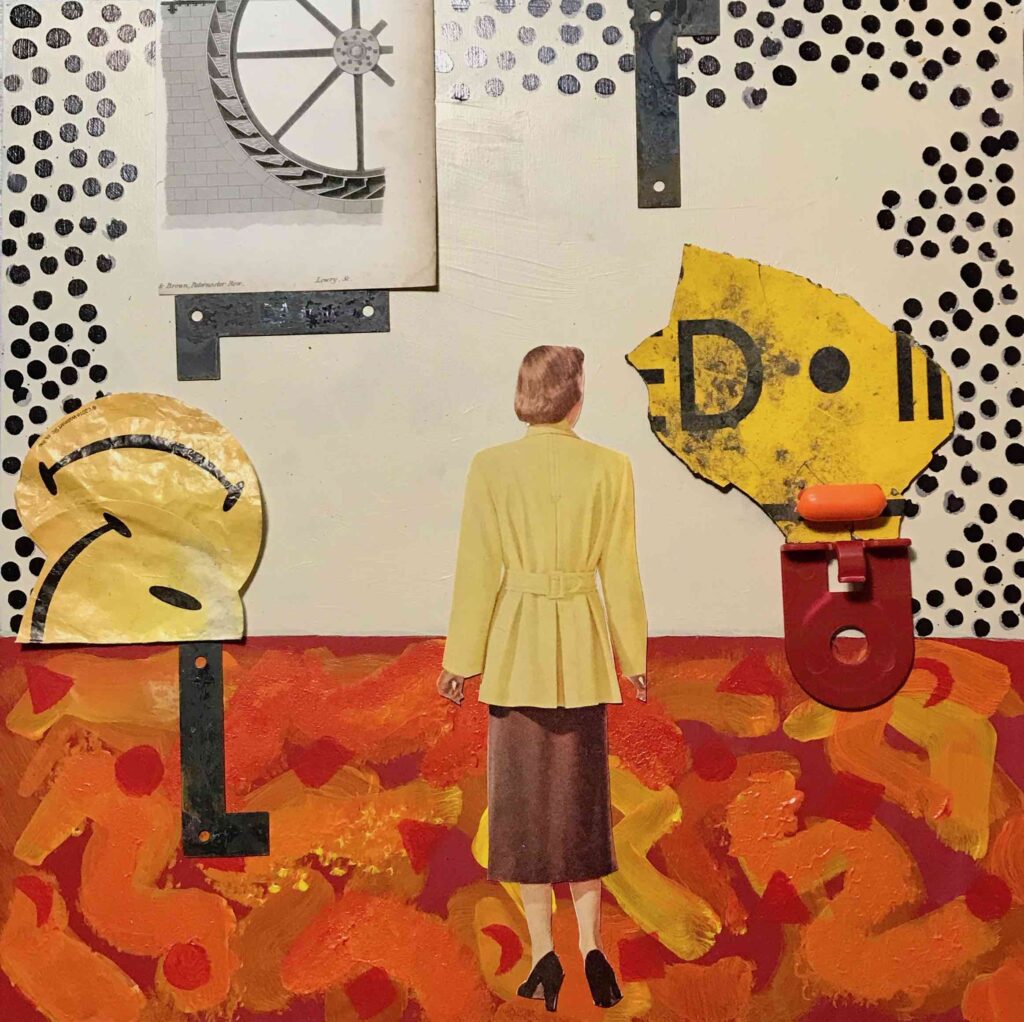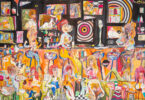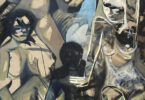Kiffi Dimond is a visual Storyteller. Her assemblages, rarely over 16 x 20 x 2″ are witty, challenging, and unnerving sometimes in the same piece. She distills the innovative principles described by Marcel Duchamp in his definition of the found object as an art form: selecting objects is a creative act, objects separated from their everyday use may become art, and a title imparts a new meaning or symbolism.
In choosing what she calls “old, authentic stuff”—manmade and natural—ranging from bits of machinery to magazine cut-outs to glass shards, Diamond relies on her intuition and designer’s eye. She arranges scenarios, adjusts proportions (sometimes quirkily), and harmonizes colors. When combined with her own drawing and painting, the disparate pieces are transformed into self-contained worlds that hover between two-and three-dimensionality. But these are not just inventive small environments. Their artistry and moods spring from Diamond’s initial response to each element. Diamond is driven by “a curiosity to uncover meaning.” She depends on “the encompassing richness” of an object’s “character, patina, history, and personality.” From her titles, we feel the emotive connections” “that turn a random assortment into an expressive whole. Her word “patina” is key: there are layers —straightforward or mysterious— below the surface. Each work captures a moment in time and offers clues to a longer story. The scene may trigger a memory or a train of thought from one’s own life or a recognition of historical realities or uncertainties. We may be amused as Diamond’s eccentric objects enact a jaunty scenario or feel anxious at their sinister implications.

wood, paper, leather and acrylic on wood panel. 20 x 16 x 2″
Dancing by the Light of Three Moons features a lively couple, kicking up their metallic heels. Diamond has a long- time fascination with Victorian ephemera. These characters conjure up the gears, springs, and inner workings of machines from steam engines to automata that enthralled the industrial age. Although at first glance assembly- line identical, small asymmetries make each one unique. Beneath their rusty heads, the calligraphic dancers feature blue, red, and green highlights and connecting wires with little circles. A map cut-out makes the earth seem unmoored in the firmament. Because—as Henry Moore noted—“a hole can itself have as much shape-meaning as a solid mass,” the white circle may be a moon or a breakthrough to another galaxy. A black new moon floats below. Scientific analysis has its limits, and the artist is not teaching astronomy but enticing us with an interplanetary fantasy. In the presence of Dancing by the Light of Three Moons, it’s easy to imagine cheerful clinking from these energetic high-steppers illuminated by magic moons.

metal, acrylic and graphite on wood panel. 16 x 20 x 1″
A more sedate duo stroll away from each other in Metazoic Tic Tok. Their clockwork-like innards suggest the specialized organs of the metazoic animal kingdom. With their freeze-frame xrays on display, the birds look more subdued than the usual Tik Tok performer. Despite the whimsical social media reference, the scene calls to mind ecological dangers: scavenging birds’ ingestion of metals, signals industrial poisons. The undulating land and sky in ochre and gray tones hint at a sunny mountainous background or perhaps a landscape dulled by pollution. The spiky plates on the birds’ backs remind us that many of these resilient dinosaur descendants now face extinction from modern environmental blight.
Evidence of human destruction dominates Predator and Rage Hands.
The predator is a figure composed of male genitals and gaping mechanical jaws, leaning menacingly toward a woman. She is mostly hidden—or perhaps thinks she is safely concealed—behind ragged edges of barbed wire and a gray fog. Spare and startling, the assemblage pairs brutality and near-invisibility.
In Rage Hands, a woman in a shirtwait dress typical of the 1950s stands gracefully posed as if on a pedestal. Her head is a pressure gauge. Her hook-like hands metal scraps that resemble voracious monster mouths about to bite. A jagged section of barbed wire presses down on a bit of ripped fabric next to her.

16 x 12 x 2″
She stands on a chaotic mass of overturned furniture, razor wire, and knifesharp blades. The wood panel bears harsh graphite scribbles. Needlelike lines fill the background. The woman’s gesture is a sign of anger but also a traditional appeal for help. The objects and artist’s drawn lines create an image of fury and despair in a dignified, unruffled dress. Has this woman suffered domestic violence or have her baleful hands repulsed it?

plastic, metal, paper, fiber and graphite on wood panel. 20 x 16 x 2″
Predator and Rage Hands are portrayals of psychological states that speak to historical and contemporary issues. Social and political commentary have been integral to assemblage since the early 20th century. Diamond notes that “I arrange objects to permit an inner dialogue to unfold.” While this refers to her creative process, it also allows viewers to explore various narratives from their own experience and worldview.
Assemblage and collage have always fostered the intersection of popular and fine art. Diamond’s adroit compositions reflect on how we value our culture, raising the question of what is worth admiration and preservation. The remnants of modern life— abandoned or artfully recycled —will be as important to historians as our works of art and architecture. Future archaeologists who unearth Diamond’s work may laugh knowingly or puzzle over its conundrums. Like the artist, they will have to rely on intuition as much as knowledge.
Center Stage may confound cultural investigators and detectives as they ponder what at first glance seems a dream-like gallery of the arts. In this 12-inch square image, colorful, vigorous brushstrokes snake across the floor. At right, torn paper in the shape of a Brâncuși-like fish with graphic markings seems to spring from a newly-painted hasp-like piece. At left, two faded and crumpled smiley-faces tumble downward and upside down. Carpenter squares hover in space, and a partial print of a brick wall and window rests against a background decorated with an arch of black dots.

metal, plastic, paper, acrylic on wood panel. 12 x 12″
Painting, architecture, printmaking, and design come together in a floating world of spatial ambiguity and strange proportions. At the center, a woman framed by a white expanse takes in the scene. Is she a stand-in for us on this stage? Or does art itself have centrality?
Diamond’s assemblages can give us an immediate and pleasing “I get it” moment, or an invitation to explore the fluid meanings and open-ended ideas of fragments re-made into wholeness. We may imagine a plot, yield to a fantasy, or discern an allusion. Or, we may delight in surrendering to André Breton’s belief that the best assemblage art “must not hesitate to bewilder sensation.” G&S
© Mary F. Holahan 2021
The Art of Kiffi Diamond Exhibition at Viridian Gallery, November 2 – 27, 2021 kiffidiamond.com





Leave a Comment